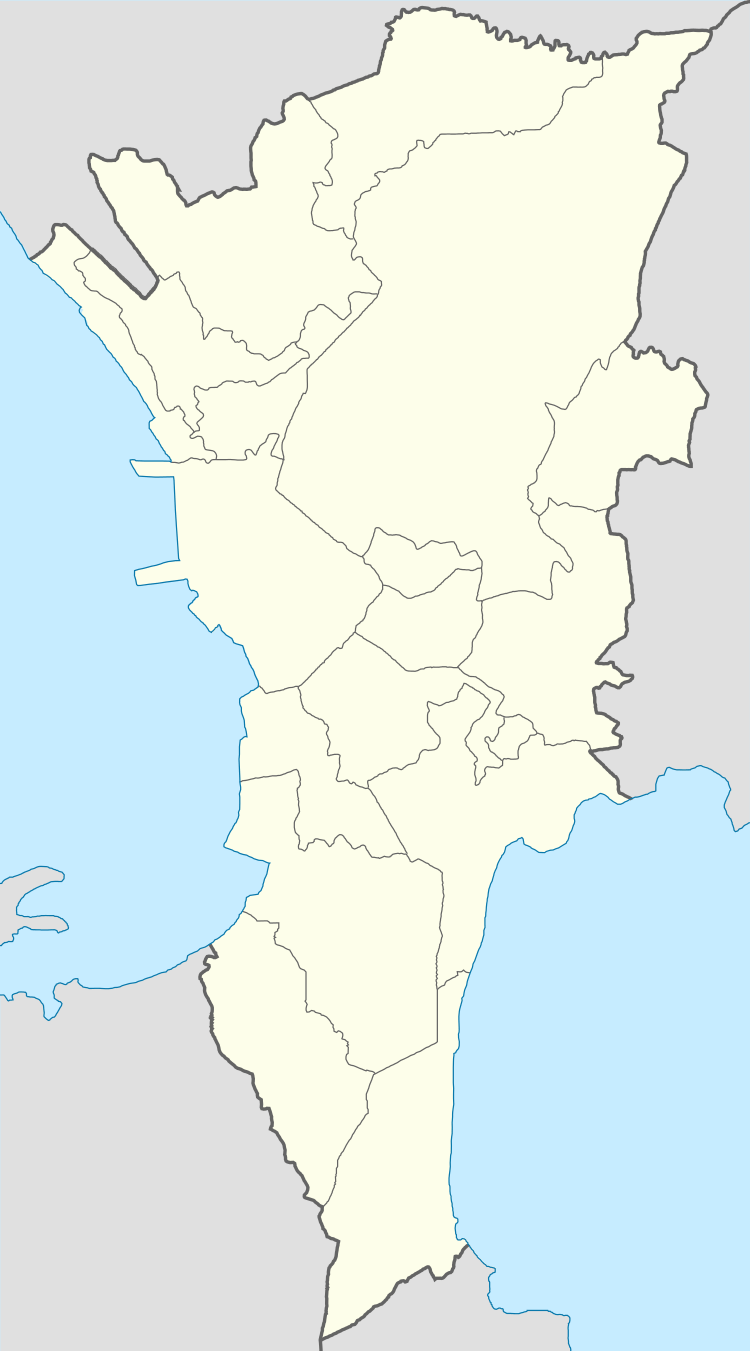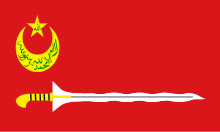Rizal Day bombings
| Rizal Day bombings | |
|---|---|
| Location | Metro Manila, Philippines |
| Date | December 30, 2000 (UTC+8) |
| Target |
Plaza Ferguson, Malate, Manila; gas station, Makati; cargo handling area, Ninoy Aquino International Airport; bus, plying the Epifanio de los Santos Avenue route; train, Blumentritt station, Manila Light Rail Transit System Line 1 |
Attack type | Black-powder bombs |
| Deaths | 22 |
Non-fatal injuries | 120[1] |
| Perpetrators | Islamist terrorists |
The Rizal Day bombings, also referred to as the December 30 bombings, were a series of bombings that occurred around Metro Manila in the Philippines on December 30, 2000. The explosions occurred in close succession within a span of a few hours. Twenty-two (22) fatalities were reported and around a hundred more suffered non-fatal injuries.[2][3][4]
The blasts occurred during a national holiday in the Philippines, where December 30 is known as Rizal Day, commemorating the martyrdom of the country's national hero, José Rizal.
Blast locations

Five locations were bombed almost simultaneously within the span of an hour. All of the locations were situated within Metro Manila on the island of Luzon.
- A bomb exploded at Plaza Ferguson in Malate, Manila. This particular blast site is located less than a hundred meters from the United States Embassy.[2]
- Another bomb detonated at a gasoline station in the Makati central business district. The target was a gasoline station along EDSA, across the street from the Dusit Hotel in Makati. Two policemen, members of the local bomb squad, died as a result of this explosion.[2][5]
- The cargo handling area of the Ninoy Aquino International Airport (NAIA) was also targeted with at least one explosive device.[2]
- Another explosive device was detonated inside a bus traveling along the Epifanio de los Santos Avenue (EDSA). The bomb exploded while the bus was en route in the Cubao area of Quezon City. One passenger was killed while several others were injured.[2]
- The explosion that claimed the most casualties occurred in a train cab at the Blumentritt station of the Metro Manila LRT Line 1.[2]
Type of explosive employed
The Philippine National Police identified the bombs as one-kilogram black-powder bombs, set to detonate using timing devices.
In addition, confessions by the convicted perpetrators describe the bombs as ammonium nitrate-based explosives. Most of the components of the bombs such as blasting caps and detonating cords were discovered to have come from the city of Talisay in the southern province of Cebu. The town itself is known for the production of blasting caps used in illegal fishing.[6]
Perpetrators
Initially, various Islamic groups were implicated in the bombings, including the Jemaah Islamiyah, the Moro Islamic Liberation Front, and the Moro National Liberation Front.[2]
In September 2003, almost three years after the incident, the case remained unsolved as the authorities responsible were berated by then-senate president Franklin Drilon.[7]
In May 2003, Saifullah Yunos (aka Mukhlis Yunos), a suspect in the bombings, was arrested in the southern city of Cagayan de Oro as he was about to board a plane to Manila. Police were alerted to the suspect when he failed to explain numerous bandages on his face and arms.[8] A month later, he confessed to a level of involvement in the bombings. A member of the Moro Islamic Liberation Front's special operations group, he was charged with multiple murder and multiple frustrated murder for his role in the bombings.[9]
In the following years, several members of the Jemaah Islamiyah were arrested for their suspected involvement in the bombings. In 2004, two Muslim men, Mamasao Naga (aka Zainal Paks) and Abdul Pata (aka Mohamad Amir) were arrested by Philippine armed forces in Marawi City. They were supposedly identified by Fathur Rahman Al-Ghozi, a known member of the Jemaah Islamiyah, as the ones responsible for the LRT-1 train cab bombing.[3][5][10]
The MILF and the MNLF were later cleared by the Philippine National Police of any involvement in the attacks.
Fathur Rahman Al-Ghozi, an Indonesian national and member of the known terrorist group Jemaah Islamiyah, was convicted and sentenced to 17 years in prison for illegal possession of explosives in relation to the Rizal Day bombing incidents. In July 2003, Al-Ghozi, along with several other accomplices, escaped from their holding cell at Camp Crame.[11] Al-Ghozi was later killed in a firefight with Philippine authorities on October 13, 2003.
On January 23, 2009, the three Rizal Day bombers, Mukhlis Hadji Yunos, Abdul Fatak Paute, and Mamasao Naga were sentenced by the Manila Regional Trial Court Branch 29, under Judge Cielito Mendaro-Grulla, of up to twenty years in imprisonment for multiple murder and multiple frustrated murder.[12]
Aftermath
In December 2006, almost six years after the bombings, Metro Manila police went on heightened alert from bomb scares and the prospect of follow-up attacks on the anniversary of the bombings.[13] The AFP followed suit days after, deploying numerous bomb squads and medical teams to both Fort Bonifacio and Luneta.[14] In addition, the PNP's Explosives and Ordnance Division and SWAT deployed teams to LRT-1 stations along Taft Avenue, near one of the original bombing sites.[15]
See also
- 2004 SuperFerry 14 bombing
- 2007 Glorietta explosion
- Christmas Eve 2000 Indonesia bombings
- Strasbourg cathedral bombing plot (Christmas 2000)
References
- "Terrorism and Counter-Terrorism in Asia: The Philippine Perspective". Archived from the original on September 14, 2005. Retrieved December 30, 2006.
- "News Summaries on Selected Topics, Mindanao Conflict, January - March 2001". Retrieved December 30, 2006.
Notes
- ↑ https://www.youtube.com/watch?v=qLNCB5L3VhA
- 1 2 3 4 5 6 7 Suerte Felipe, Cecille; James Mananghaya (December 19, 2006). "After CBCP rally, PNP prepares for Rizal Day bombing anniversary". The Philippine Star. Retrieved March 14, 2010.
- 1 2 Fernandez, Jonathan F. (August 4, 2004). "2 Rizal Day 'bombers' nabbed". Sun Star Manila. Sun Star Publishing, Inc. Retrieved February 8, 2007.
- ↑ "Rizal Day bombing chronology". GMA News Research. GMA News. January 23, 2009. Archived from the original on January 29, 2009. Retrieved March 14, 2010.
- 1 2 Pulta, Benjamin; Miko Santos (December 30, 2003). "Gov't seeks re-raffling of LRT-1 bombing case". Sun Star Manila. Sun Star Publishing, Inc. Retrieved February 8, 2007.
- ↑ Bacalla, Tess B. (March 14, 2005). "Coastal City is Hub of Underground Explosives Trade". Our Latest Report. Philippine Center for Investigative Journalism. Archived from the original on February 27, 2009. Retrieved February 14, 2007.
- ↑ "Drilon urges authorities to solve Rizal Day bombing". Sun Star Manila. Sun Star Publishing, Inc. September 14, 2003. Retrieved February 14, 2007.
- ↑ Sy Egco, Joel M. (May 26, 2003). "Rizal Day suspect caught". News: Police. Manila Standard Today. Retrieved February 15, 2007.
- ↑ "Mukhlis Yunos admits Rizal Day bombings" (PDF) (Press release). Philippine National Police. June 9, 2003. Retrieved February 14, 2007.
- ↑ McKenna, Terence (October 2004). "InDepth: Passport to Terror". CBC News. Archived from the original on February 12, 2009. Retrieved March 14, 2010.
- ↑ Sy Egco, Joel M.; Fel V. Maragay (July 15, 2003). "Rizal Day bomber escapes". Manila Standard Today. Archived from the original on October 12, 2007. Retrieved February 15, 2007.
- ↑ Torres, Tetch (January 23, 2009). "Rizal Day bombers get 20 years in jail". Philippine Daily Inquirer. Archived from the original on January 29, 2009. Retrieved January 23, 2009.
- ↑ Vargas, Anthony (December 26, 2006). "Rizal Day bombing still haunts Metro cops". The Manila Times Online. The Manila Times Publishing Corp. Archived from the original on October 27, 2007. Retrieved February 14, 2007.
- ↑ Vargas, Anthony (December 30, 2006). "AFP vows vigilance on Rizal Day". The Manila Times Online. The Manila Times Publishing Corp. Archived from the original on May 13, 2007. Retrieved February 14, 2007.
- ↑ "Philippine police tightens security ahead of anniversary of Rizal Day bombing". World News. People's Daily Online. December 29, 2006. Retrieved February 14, 2007.

